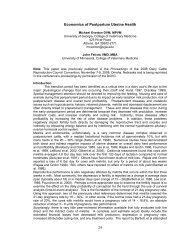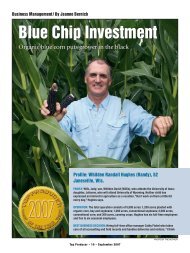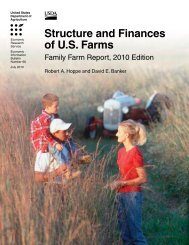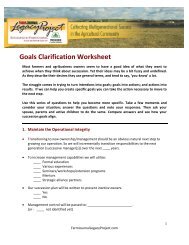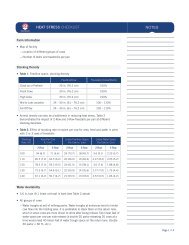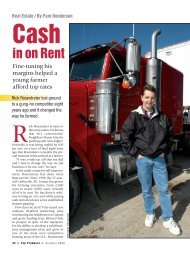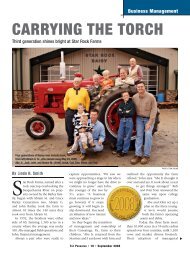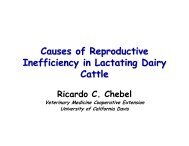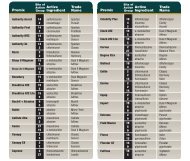Yields at Covel Creek <strong>Farm</strong>s 2006This plot shows <strong>the</strong> yield impact of disease even though<strong>the</strong> plot was sprayed with fungicide. Disease pressure,and <strong>the</strong> amount of down corn, increased at <strong>the</strong> higherpopulations, especially in <strong>the</strong> twin rows.Located near Leroy, Ill., McLaughlin-Dooley <strong>Farm</strong>soffered a second location to compare 30" rows with twinrows on 30" centers. The corn followed soybeans. Thislocation was short on moisture but had <strong>the</strong> most rainof all of <strong>the</strong> six locations. However, uniform soil densitywas <strong>the</strong> key for <strong>the</strong> field’s ability to capture <strong>the</strong> rain thatarrived largely in surprise pop-up storms.farm to plant four populations (30,000, 32,000, 34,000 and 37,000ppa) with <strong>the</strong> custom-built plot planter in 30" and twin rows andan additional Great Plains drill set up for twin rows.Yields for both sets of twin rows continued to climb—even at<strong>the</strong> 37,000 planting population. While <strong>the</strong> twins were postingyield gains as <strong>the</strong> population climbed, <strong>the</strong> 30" rows were doingwhat we expected based on previous plots and for <strong>the</strong> plotconsiderations and hybrid selection—peaking at 32,000 to 34,000ppa and <strong>the</strong>n declining.In <strong>the</strong> variety plots, our initial work with six popular numbersfor <strong>the</strong> area clearly showed that some varieties take to twin rowsbetter than o<strong>the</strong>rs. In 2003, three of <strong>the</strong> corn varieties yieldedA team effort from three operations near Grand Ridge, Ill., made this plot possible.They were R & D Walter, Hybrid Service and Covel Creek <strong>Farm</strong>s.<strong>Narrow</strong> <strong>Row</strong> <strong>Corn</strong> <strong>Report</strong> 03A team effort involving R & D Walter <strong>Farm</strong>s, Hybrid Serviceand John Thomas provided <strong>the</strong> chance to test 20", 30"and twin rows in a high-yield, longtime continuous cornsetting. High Illinois Soil N <strong>Test</strong> (ISNT) values point to <strong>the</strong>yield potential of <strong>the</strong> field.best in twin rows, two did worse, and yields for one were about<strong>the</strong> same as in <strong>the</strong> 30" rows.2004 to 2005 In <strong>the</strong> next years, <strong>the</strong> focus was on <strong>the</strong>elements needed to make narrow rows successful: plantingpopulations, hybrid selection, and <strong>the</strong> rates and placement forstarter, insecticide and nitrogen. Each variable was tested in awide range of soils and growing conditions (“Make Twin <strong>Row</strong>sCount,” Mid-February 2005). The effort continued to reveal <strong>the</strong>best way to go about growing narrow rows and on how twinscompare with 20" rows, ano<strong>the</strong>r narrow-row route to bumpingcorn yields.For <strong>the</strong> next couple of years, <strong>the</strong> test plots involved six Illinoislocations, spanning from near Springfield north to Grand Ridge,just south of Chicago. In general, <strong>the</strong> plot data repeated <strong>the</strong>population results of previous plots, showing that some hybridsare more suited for narrow rows and indicating that <strong>the</strong> hybridsgood for 20" rows also work well for twin rows.At <strong>the</strong> Peak Bro<strong>the</strong>rs plot near Springfield, starter wasapplied and FMC supplied a liquid applicator for Captureinsecticide (using <strong>the</strong> Great Plains tanks and FMC nozzles). TheGreat Plains Yield-Pro twin-row planter was compared with <strong>the</strong>Peak’s 16-row, 30" Kinze planter,outfitted with Precision Plantingmeters set for <strong>the</strong> seed size. Twelvefingermeters were used for <strong>the</strong> 30"rows and six-finger meters wereused for <strong>the</strong> twins, so <strong>the</strong> meterscould run at <strong>the</strong> same revolutionsper minute. In 2004, <strong>the</strong> Peak plotslooked at twin-row populationsranging from 28,700 to 48,000 ppa.For this hybrid in those plotconditions, yields climbed with <strong>the</strong>population until 38,000 ppa and <strong>the</strong>nstarted to trend down (see chart:Yields at Peak Bro<strong>the</strong>rs <strong>Farm</strong> 2004).
In 30" rows plot at McLaughlin-Dooley <strong>Farm</strong>s, you cansee <strong>the</strong> sunlight is able to reach <strong>the</strong> ground in between<strong>the</strong> canopyAt <strong>the</strong> same plot as shown to <strong>the</strong> left, <strong>the</strong> twin rows havea tighter canopy, which led to conserving water by shading<strong>the</strong> ground.In 2005, <strong>the</strong> second year at Peaks farm also showed consistentperformance by <strong>the</strong> twins (see chart: Yields at Peak Bro<strong>the</strong>rs<strong>Farm</strong> 2005). Populations were compared for <strong>the</strong> twins and 30"rows at five levels ranging from 28,700 to 36,000 ppa. The entireplot was sprayed with fungicide for disease. Even so, <strong>the</strong> twinrows suffered more disease pressure than <strong>the</strong> 30" rows. Whencomparing year-to-year results, it became apparent <strong>the</strong>re arecertain hybrids and certain soils that can and need to be pushedwith higher populations. Inconsistency in response to populationcan be attributed to <strong>the</strong> hybrid’s characteristics of being flex- orfixed-ear type. To find <strong>the</strong> upper limit in pushing populations,<strong>the</strong> first consideration should be <strong>the</strong> hybrid’s capabilities and<strong>the</strong>n <strong>the</strong> growing conditions.McLaughlin-Dooley <strong>Farm</strong>s near Leroy offered a secondopportunity to compare 30" rows with twin rows. The same rigused at Peaks put in <strong>the</strong> twins, and <strong>the</strong> 30" treatments went inwith <strong>the</strong> farm’s John Deere 7200 vacuum planter. The twinsoutpaced <strong>the</strong> 30" at every planting population above 28,000 ppa(see chart: Yields at McLaughlin-Dooley <strong>Farm</strong>s).At Gregg Sauder’s farm near Tremont, <strong>the</strong> twin rows werecompared to 20" rows. The Great Plains Yield-Pro planterplanted <strong>the</strong> twins, and Sauder’s 36-row Kinze planter put in <strong>the</strong>20" rows. Precision Planting meters were used in both machines,and care was again taken for <strong>the</strong> meters to operate at <strong>the</strong> samespeed. <strong>Plot</strong>s were put in both corn-on-cornand corn/soybean rotations. The back-tobackcorn yielded 10 bu. to 15 bu. per acrehigher than <strong>the</strong> corn following beans. In2004 <strong>the</strong>re was a slight advantage to <strong>the</strong> twinrows, and in 2005 <strong>the</strong>re was an advantage to<strong>the</strong> 20" rows. The data showed that twinrows and 20" rows have similar yieldadvantages compared with 30" rows.Near Grand Ridge, test plot cooperatorJohn Thomas put in twin-row plots in cornon-cornand corn-on-bean fields. He built aplanter for <strong>the</strong> job. A hitch, called a planterpull arm, built by Meteer Manufacturing inA<strong>the</strong>ns, Ill., links two 12-row, 30" plantersinto one rig. Thomas and son Rob set it upso that <strong>the</strong> rear machine runs 7½" to <strong>the</strong> leftof <strong>the</strong> front planter. He used Bt-rootwormhybrids so insecticide wasn’t an issue andcompared twins with 30" rows. The plots<strong>Narrow</strong> <strong>Row</strong> <strong>Corn</strong> <strong>Report</strong> 04Bu. per acre compared to 30” yield +/-20151050-5were impacted by disease to <strong>the</strong> extent that <strong>the</strong> yield resultswere compromised (see chart: 2006 Yields at Covel Creek<strong>Farm</strong>s).Thomas took his planter to R & D Walter <strong>Farm</strong>s, GrandRidge, to help put in a plot comparing twins, 30" and 20" rows.Ralph and Don Walter used <strong>the</strong>ir 30" planter and 20" planter,and Hybrid Service provided <strong>the</strong> 20" combine head andcombine. Both corn-on-corn and corn-on-bean plots wereplanted. Two varieties were used with a split-planter setup. Onehybrid barely showed a response to row spacing or population,while <strong>the</strong> o<strong>the</strong>r responded aggressively. The Grand Ridge groupplanted <strong>the</strong>ir plot in a longtime continuous corn field with highIllinois Soil N <strong>Test</strong> (ISNT) values built by years of manureapplications and corn-on-corn production. The high-yieldenvironment is suited for higher planting populations. In 2005,<strong>the</strong> plot yielded extremely well considering that it had less rainthan any of <strong>the</strong> o<strong>the</strong>r locations included in <strong>the</strong> effort. Thedownside of <strong>the</strong> many years of continuous corn is that <strong>the</strong> fieldis a welcome mat for disease (see charts: Yields at Grand Ridgewith Fungicide and without Fungicide).The data points to 34,000 to 36,000 ppa as <strong>the</strong> top end for mosthybrids in medium to light soils. At <strong>the</strong> same time, populationsneed to be pushed more in fields with heavier soils, greaterwater-holding capacity and higher ISNT values—as seen in <strong>the</strong>Yields at Kuntz <strong>Farm</strong> 20081 2 3 4 5 6 7 8 9 10 11 12 13 14 15 16 17 18 19 20 21 22 23 24 25 26ReplicationsThe chart shows twin row yield compared with 30" row yield (plus or minus).Overall, <strong>the</strong> twin rows averaged 7 bu. greater than <strong>the</strong> 30" rows.



